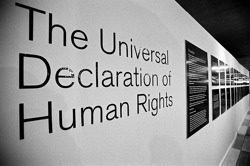The human face of climate change has tended to be obscured by technical and scientific issues. Much of the discussion of climate change has revolved around technicalities such as carbon emissions. The jargon used mostly precludes non-scientists from understanding the issue.
There has been a recent shift in that perspective, hoping that beginning a conversation on the relationship between human beings and climate change would help humanize the face of climate change.
Human rights became the paradigm through which the human dimension of climate change was explored. Perhaps an interesting starting point would be to ask: why human rights?
Bridging Climate Change with Human Rights

What makes them particularly suited to discussing the interrelationship between climate change and human beings? Human rights are most popularly defined as rights that are inherent to human beings. Their existence is contingent to humanity.
As human beings, we are entitled to a range of rights that have nothing to do with class, religion, and color. Human rights, therefore, are a consequence of shared humanity. A range of universal rights have been afforded protection and status by their expression and inclusion in international law through treaties, conventions, and customary practice.
Using the framework of international human rights law as its reference point, the Office of the High Commissioner for Human Rights, United Nations, commissioned a report on the relationship between human rights and climate change. Interestingly, the study was carried out pursuant to the United Nations Resolution tabled by the Maldives, urging consideration of the challenges that climate change presents to protecting human rights.
Climate Change Threatens Human Rights
Climate change threatens various rights, including the right to life, food, adequate housing, and livelihood. The report speaks to each of these individually, placing them in the context of climate change and how it erodes protection by compromising states’ ability to fulfill their obligations to their citizens.
Although many of these rights are standalone, they are all intrinsically linked to the right to life. What is the value of other rights when there is no life to live? Several themes define the relationship between rights—interrelatedness, interdependence, and indivisibility. Nowhere is this clearer than in how climate change continues to challenge our very existence.
The problem with being human is that we are only willing to act when we can clearly see the impact of our doing. This is especially true of collective and international action. Negotiations on climate change are essentially political. Often, the short-term tenures of political office dictate how agendas are addressed.
Climate change is not politically opportune, not least because it demands longer-term sustainable measures and is dependent on persistent and continuous political will, which is not always possible given the changes in government. In addition, the cost of developing global solutions will likely be very high in the short run.
The Role of International Law in Climate Action
Human rights can have the effect of summoning governments. Under the banner of international human rights obligations, the call to address climate change can be strengthened. For instance, the norm of international cooperation envisaged by the International Covenant on Economic, Social, and Cultural Rights, the Charter of the United Nations, and other developmental frameworks such as the Millennium Development Goals (now superseded by the Sustainable Development Goals) can be used to bear on governments to institute a global call of action and delivery.
Developing states can use the covenants and their rights obligations as shields for their citizen’s rights, ensuring that assistance programs and development aid do not result in them violating their obligations. A rights-based approach to climate change will help secure sustainable courses of action even in policies that address climate change.
It is not enough to merely address climate change. It is also essential to ensure that mitigation and adaptation actions under the United Nations Framework Convention on Climate Change do not promote degradation and hardship. A prime example was the production of biofuel that caused upward spikes in food prices, compromising the right to food.
A Work in Progress
The contour of the relationship between human rights and climate change is a work in progress. The report of the Office of the High Commissioner for Human Rights is the beginning of a conversation. It is by no means conclusive. Especially in some of the areas it identifies, examples include vulnerable groups of persons, human migration, and indigenous rights. These are issues that the contemporary world will have to begin to address sooner rather than later. At best, we can begin to speak of a rights-based approach to climate change…
Also, recognize that this is a crucial time to act. The run-up to Copenhagen demands action within the human rights community. A strong rights voice must be heard in Copenhagen.


